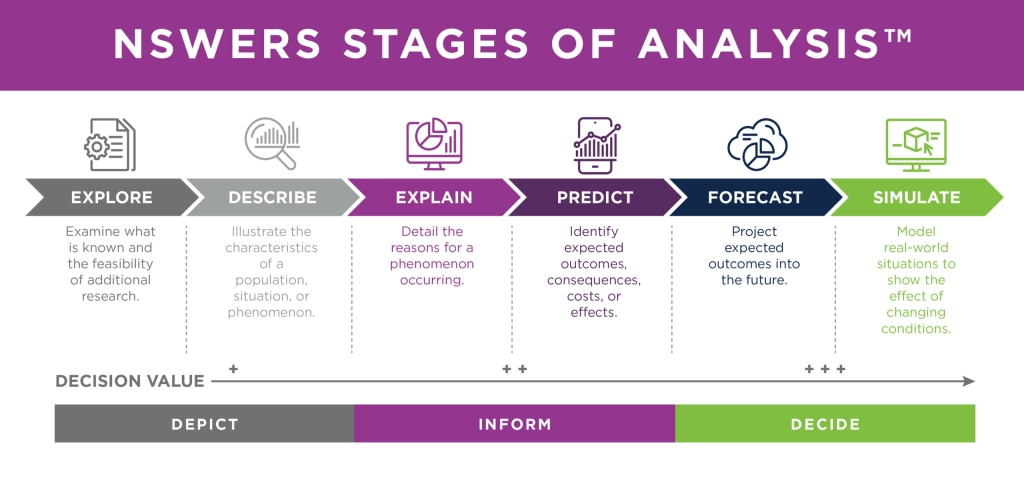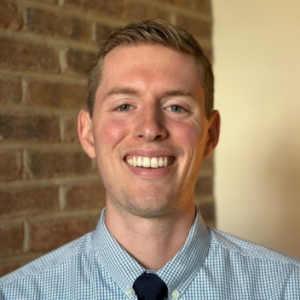In today’s rapidly evolving educational landscape, there is a growing demand to ensure that policies and practices, particularly in Career and Technical Education (CTE), are informed by research and evidence. When we measure what works and what doesn’t, more informed decisions can be made to enhance learner success. Informed decision-making is essential, but sometimes, a gap exists between the type of evidence needed to make decisions and the evidence that is produced.
Advance CTE’s Spring Meeting featured a plenary session on this topic, “Building Evidence on Best Practices to Serve CTE Learners.” Advance CTE Research Associate Marie Falcone opened the session, emphasizing the importance of grounding decisions made at the state level in strong evidence that genuinely improves outcomes for learners. Translating that evidence into actionable policy, however, remains a challenge. Falcone pointed out that while decision-makers often have access to some data and research, leveraging that information effectively for impactful change is not always straightforward.
This is where two experts came in. Dr. Shaun Dougherty, an education and policy researcher at Boston College, shared insights into the field of research, and Dr. Katie Graham, the Nebraska State CTE Director, dove into her state’s process for conducting research as well as connecting research to decision-making.
The State of Evidence in CTE
Dr. Dougherty first discussed the current state of evidence on CTE. He discussed various delivery models of programs of study at the secondary level and how integrating CTE positively impacts those schools and leads to better outcomes related to the workforce and college. For example, one study commissioned by Dr. Dougherty demonstrated that CTE helps ease transitions to college and the workforce, but its outcomes vary by gender. As a researcher, Dr. Dougherty made it clear that to build evidence, researchers need to determine what, where, and for whom CTE is offered and under what conditions.
That leads us to ask: what is it we don’t know but should?
Dr. Dougherty argues that while we have limited knowledge of what works best in settings where most students receive CTE, there are opportunities to learn from natural experiments and overenrolled programs. He identified the field needs more research on college certificates and degree completion, with intentional connections between K-12 and postsecondary research. Dr. Dougherty notes that there are many factors at play in the field, which necessitate examining the entire field of play and its supporting players. This includes understanding the role that industry-recognized credentials play and devising models to expand the CTE teacher pipeline, thereby contributing to certificate and degree completion.
Dr. Dougherty identified several areas for policy reform that are needed to enable the collection of evidence on these topics through research. The first is scaling effective programs while managing the cost, access, and personnel it takes to support high-quality CTE. Second, structuring programs to engage employers and connect youth is a challenge that ensures meaningful work-based learning and dynamic alignment to workforce needs. Third, we need the integration of community colleges to align pathways and share resources, thereby reducing costs and expanding programs.
Nebraska: A Model for State-Led CTE Evidence Building
“Why” – Research to Action
Dr. Graham showcased Nebraska’s commitment to grounding its CTE decisions in strong research, sharing several state-level projects conducted across key pillars of CTE. Without research, states may continue to invest in outdated programs, make policy decisions based on assumptions, and struggle to demonstrate the impact of CTE on policymakers and learners alike. In Nebraska, this means moving research to action to ensure program relevance and promote access.
Just one example of Nebraska going beyond the typical for research and collaboration is the 2021 partnership with South Dakota CTE partners and the Regional Educational Laboratory Central to investigate the impact of completing a sequence of CTE courses (known as being a CTE Concentrator) on students’ rates of on-time high school graduation, as well as their rates of postsecondary enrollment and completion within two and five years. The research questions were:
What is the impact of being a CTE Concentrator on high school graduation, two-year and five-year postsecondary enrollment and completion, and the type of postsecondary award attained?
How do high school graduation and two-year and five-year postsecondary outcomes vary by Career Cluster?
A quasi-experimental research project ensued, sampling 112,764 students in NE and SD whose high school graduation was expected between 2012-13 and 2016-17 and 42,398 students from 2012-13 to 2013-14 as graduation cohorts for the five-year measure. They ran a logistic regression and provided a descriptive analysis.
One standout finding? CTE students in Nebraska are “quicker out of the gate,” often transitioning more efficiently into postsecondary education or the workforce.
The TL;DR is CTE Concentrators were more likely to
- Graduate from high school on time
- Enroll in postsecondary education
- Earn any kind of postsecondary award within two years and five years of their expected graduation year
This study led state policymakers to pass legislation that provided state categorical funding for CTE, ensuring local education agencies had access to more funds to drive further outcomes supported by research.
“How” – Discover & Engage
Dr. Graham also continued the conversation about building evidence by sharing proactive and reactive strategies for discovering and engaging with research.
Proactive strategies:
- Partnerships with Research Organizations
- Legislative/Policy Analysis
- Landscape Analyses
Reactive strategies:
- Identifying Gaps in Policy/Practice
- Responding to Emerging Needs
Proactive efforts to build evidence led to the development of, in Dr. Graham’s words, “the most comprehensive education-to-workforce longitudinal information source ever created in Nebraska.” NSWERS – Nebraska Statewide Workforce & Educational Reporting System – creates a culture of data-informed decision-making that supports pathways of earning and learning across the state.
NSWERS engages decision-makers through a six-stage process, as shown above, to inform strategic decisions and address questions arising from education and workforce gaps. The questions can get specific and are tied to the broader CTE system. Dr. Graham shared several questions that could be answered through this system, including:
- High School Graduation: Are students who engage in CTE earlier (e.g., 8th and 9th grade) more likely to graduate on time? How much does a student’s probability of graduating increase when they take two CTE courses? Three CTE courses?
- Postsecondary Persistence: Can we identify risk factors predictive of postsecondary persistence for CTE students to better target supports? What are the top CTE program areas that lead to the highest rates of postsecondary persistence?
- Employment Gap: What percentage of students with a CTE background fill H3 jobs in the state/region, and how does this compare to projected labor shortages? How does the length of time between postsecondary graduation and securing full-time employment differ for students who completed a work-based learning experience versus those who did not?
- Industry Placement: What is the 10-year earnings differential between CTE concentrators who enter the workforce after high school vs. those who earn a two-year degree? Credential?
On the horizon, there can always be more questions to research and evidence to build, but if state CTE systems connect that research to the needs of learners, outcomes should improve. States like Nebraska and research practitioners like Dr. Dougherty are two strong examples of how building evidence can close learning and opportunity gaps for learners by improving CTE systems.





